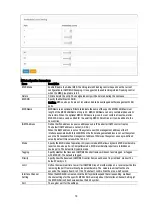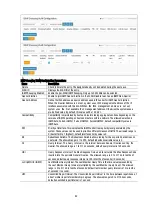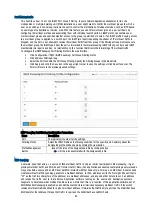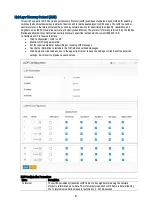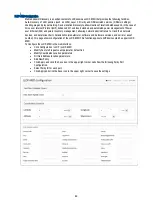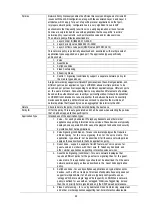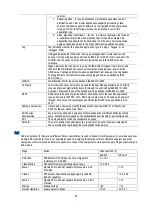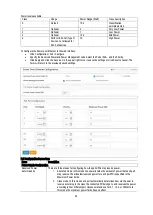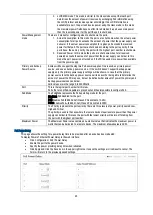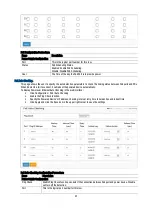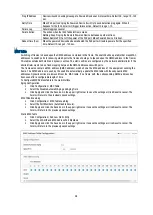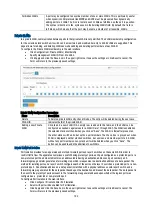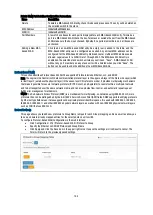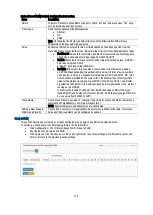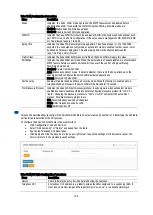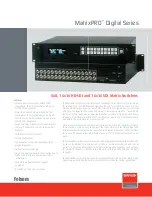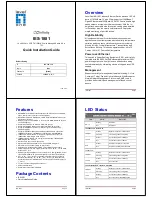
93
services.
7.
Streaming Video - for use by broadcast or multicast based video content
distribution and other similar applications supporting streaming video
services that require specific network policy treatment. Video applications
relying on TCP with buffering would not be an intended use of this
application type.
8.
Video Signaling (conditional) - for use in network topologies that require
a separate policy for the video signaling than for the video media. This
application type should not be advertised if all the same network policies
apply as those advertised in the Video Conferencing application policy.
Tag
Tag indicating whether the specified application type is using a 'tagged' or an
'untagged’ VLAN.
Untagged indicates that the device is using an untagged frame format and as such
does not include a tag header as defined by IEEE 802.1Q-2003. In this case, both the
VLAN ID and the Layer 2 priority fields are ignored and only the DSCP value has
relevance.
Tagged indicates that the device is using the IEEE 802.1Q tagged frame format, and
that both the VLAN ID and the Layer 2 priority values are being used, as well as the
DSCP value. The tagged format includes an additional field, known as the tag header.
The tagged frame format also includes priority tagged frames as defined by IEEE
802.1Q-2003.
VLAN ID
VLAN identifier (VID for the port as defined in IEEE 802.1Q-2003.
L2 Priority
L2 Priority is the Layer 2 priority to be used for the specified application type. L2 Priority
may specify one of eight priority levels (0 through 7), as defined by IEEE 802.1D-2004.
A value of 0 represents use of the default priority as defined in IEEE 802.1D-2004.
DSCP
DSCP value to be used to provide Diffserv node behavior for the specified application
type as defined in IETF RFC 2474. DSCP may contain one of 64 code point values (0
through 63). A value of 0 represents use of the default DSCP value as defined in RFC
2475.
Adding a new policy
Click to add a new policy. Specify the Application type, Tag, VLAN ID, L2 Priority and
DSCP for the new policy. Click "Save".
Port Policies
Configuration
Every port may advertise a unique set of network policies or different attributes for the
same network policies, based on the authenticated user identity or port configuration.
Port
The port number to which the configuration applies.
Policy ID
The set of policies that shall apply to a given port. The set of policies is selected by
check marking the checkboxes that corresponds to the policies.
PoE
PoE is an acronym for Power over Ethernet. Power over Ethernet is used to transmit electrical power to remote devices over
standard Ethernet cable. It could, for example be used for powering IP cameras, wireless LAN access points and other
equipment, where it would be difficult or expensive to connect the equipment to main power supply. Stages of powering up
PoE Link are:
Stage
Action
Volts specified [V]
802.3af
802.3at
Detection
PSE detects if the PD has the correct signature
resistance of 19-26
k
Ω
2.7-10.1
Classification
PSE detects resistor indicating power range
12.5-20.5
Mark 1
Signals PSE is 802.3at capable. PD presents a 0.25-
4mA load.
-
7-10
Class 2
PSE outputs classification voltage again to indicate
802.3at capability
-
14.5-20.5
Mark 2
Signals PSE is 802.3at capable. PD presents a 0.25-4
mA load.
-
7-10
Startup
Startup voltage
>42
>42
Normal Operation
Supply power to device
37-45
42.5-57

